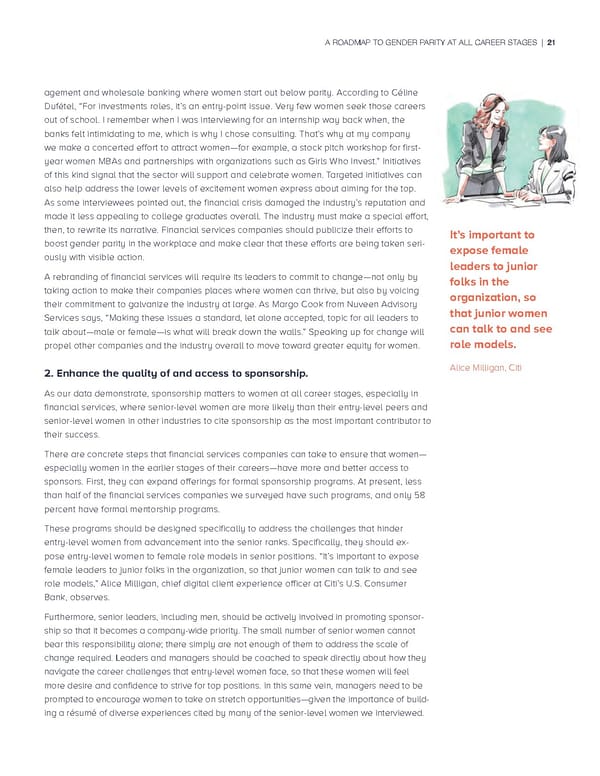A ROADMAP TO GENDER PARITY AT ALL CAREER STAGES | 21 agement and wholesale banking where women start out below parity. According to Céline Dufétel, “For investments roles, it’s an entry-point issue. Very few women seek those careers out of school. I remember when I was interviewing for an internship way back when, the banks felt intimidating to me, which is why I chose consulting. That’s why at my company we make a concerted effort to attract women—for example, a stock pitch workshop for first- year women MBAs and partnerships with organizations such as Girls Who Invest.” Initiatives of this kind signal that the sector will support and celebrate women. Targeted initiatives can also help address the lower levels of excitement women express about aiming for the top. As some interviewees pointed out, the financial crisis damaged the industry’s reputation and made it less appealing to college graduates overall. The industry must make a special effort, then, to rewrite its narrative. Financial services companies should publicize their efforts to It’s important to boost gender parity in the workplace and make clear that these efforts are being taken seri- expose female ously with visible action. leaders to junior A rebranding of financial services will require its leaders to commit to change—not only by folks in the taking action to make their companies places where women can thrive, but also by voicing organization, so their commitment to galvanize the industry at large. As Margo Cook from Nuveen Advisory that junior women Services says, “Making these issues a standard, let alone accepted, topic for all leaders to talk about—male or female—is what will break down the walls.” Speaking up for change will can talk to and see propel other companies and the industry overall to move toward greater equity for women. role models. 2. Enhance the quality of and access to sponsorship. Alice Milligan, Citi As our data demonstrate, sponsorship matters to women at all career stages, especially in financial services, where senior-level women are more likely than their entry-level peers and senior-level women in other industries to cite sponsorship as the most important contributor to their success. There are concrete steps that financial services companies can take to ensure that women— especially women in the earlier stages of their careers—have more and better access to sponsors. First, they can expand offerings for formal sponsorship programs. At present, less than half of the financial services companies we surveyed have such programs, and only 58 percent have formal mentorship programs. These programs should be designed specifically to address the challenges that hinder entry-level women from advancement into the senior ranks. Specifically, they should ex- pose entry-level women to female role models in senior positions. “It’s important to expose female leaders to junior folks in the organization, so that junior women can talk to and see role models,” Alice Milligan, chief digital client experience officer at Citi’s U.S. Consumer Bank, observes. Furthermore, senior leaders, including men, should be actively involved in promoting sponsor- ship so that it becomes a company-wide priority. The small number of senior women cannot bear this responsibility alone; there simply are not enough of them to address the scale of change required. Leaders and managers should be coached to speak directly about how they navigate the career challenges that entry-level women face, so that these women will feel more desire and confidence to strive for top positions. In this same vein, managers need to be prompted to encourage women to take on stretch opportunities—given the importance of build- ing a résumé of diverse experiences cited by many of the senior-level women we interviewed.
 Closing the Gap Page 22 Page 24
Closing the Gap Page 22 Page 24